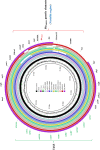Dissemination and Stability of the blaNDM-5-Carrying IncX3-Type Plasmid among Multiclonal Klebsiella pneumoniae Isolates
- PMID: 33148824
- PMCID: PMC7643832
- DOI: 10.1128/mSphere.00917-20
Dissemination and Stability of the blaNDM-5-Carrying IncX3-Type Plasmid among Multiclonal Klebsiella pneumoniae Isolates
Abstract
NDM-5 carbapenemase was mainly identified in Escherichia coli, while the rapid transmission of blaNDM-5 among Enterobacteriaceae has raised serious public attention. This study identified 14 NDM-5-producing Klebsiella pneumoniae isolates from 107 carbapenem-resistant K. pneumoniae isolates, recovered from blood, urine, and normally sterile body fluids of pediatric patients from January 2016 to December 2018. All NDM-5-producing isolates were highly resistant to β-lactams, while tigecycline and polymyxin B exhibited excellent antimicrobial activity. These 14 strains belonged to 9 different sequence types (STs) and displayed various pulsed-field gel electrophoresis (PFGE) patterns, suggesting that they were not clonally related. S1-PFGE followed by Southern blotting showed that the blaNDM-5 gene was located on an ∼46-kb IncX3 plasmid in all strains. All blaNDM-5-carrying plasmids were successfully transferred into recipient E. coli J53. PCR-based sequencing demonstrated that all of the blaNDM-5-carrying plasmids shared highly similar backbones, with nucleotide sequence identity of >99%. Moreover, this plasmid displayed high sequence similarity to the previously reported epidemic IncX3 blaNDM-5-carrying plasmids, with dynamic changes observed only in blaNDM-5-surrounding elements. Interestingly, the IncX3 blaNDM-5-carrying plasmids showed strong stability in clinical isolates when cultured in antibiotic-free medium. However, after the conjugation inhibitor linoleic acid was added, a gradual increase in the level of IncX3 plasmid loss could be observed. Clinical isolates displayed 10% to 15% blaNDM-5-carrying plasmid loss after coculture with linoleic acid for 5 days. These results showed that the IncX3 plasmid facilitated the dissemination of blaNDM-5 among multiclonal K. pneumoniae strains in children and that conjugal transfer contributed significantly to IncX3 plasmid stability within K. pneumoniaeIMPORTANCE The emergence and spread of New Delhi metallo-β-lactamase (NDM)-producing Enterobacteriaceae have been a serious challenge to public health, and NDM-5 shows increased resistance to carbapenems compared with other variants. NDM-5 has been identified mostly in E. coli but has rarely been described in K. pneumoniae and other Enterobacteriaceae isolates. Here, we present the dissemination of highly similar 46-kb IncX3 blaNDM-5-carrying plasmids among multiclonal K. pneumoniae strains in children, highlighting the horizontal gene transfer of blaNDM-5 among K. pneumoniae strains via the IncX3 plasmid. Moreover, the IncX3 blaNDM-5-carrying plasmids displayed strong stability in clinical strains when cultured in antibiotic-free medium, and the plasmid maintenance was attributed partly to conjugal transfer. Plasmid conjugation is mediated by the type IV secretion system (T4SS), and T4SS is conserved among all epidemic IncX3 blaNDM-5-carrying plasmids. Therefore, combining conjugation inhibition and promotion of plasmid loss would be an effective strategy to limit the conjugation-assisted persistence of IncX3 blaNDM-5-carrying plasmids.
Keywords: IncX3 plasmid; K. pneumoniae; NDM-5; conjugal transfer; plasmid stability.
Copyright © 2020 Zhu et al.
Figures


Similar articles
-
Dissemination of the blaNDM-5 Gene via IncX3-Type Plasmid among Enterobacteriaceae in Children.mSphere. 2020 Jan 8;5(1):e00699-19. doi: 10.1128/mSphere.00699-19. mSphere. 2020. PMID: 31915216 Free PMC article.
-
Dissemination of blaNDM-5 gene via an IncX3-type plasmid among non-clonal Escherichia coli in China.Antimicrob Resist Infect Control. 2018 Apr 26;7:59. doi: 10.1186/s13756-018-0349-6. eCollection 2018. Antimicrob Resist Infect Control. 2018. PMID: 29713466 Free PMC article.
-
Spreading Patterns of NDM-Producing Enterobacteriaceae in Clinical and Environmental Settings in Yangon, Myanmar.Antimicrob Agents Chemother. 2019 Feb 26;63(3):e01924-18. doi: 10.1128/AAC.01924-18. Print 2019 Mar. Antimicrob Agents Chemother. 2019. PMID: 30530602 Free PMC article.
-
Diversity, functional classification and genotyping of SHV β-lactamases in Klebsiella pneumoniae.Microb Genom. 2024 Oct;10(10):001294. doi: 10.1099/mgen.0.001294. Microb Genom. 2024. PMID: 39432416 Free PMC article.
-
Prevalence of genes encoding carbapenem-resistance in Klebsiella pneumoniae recovered from clinical samples in Africa: systematic review and meta-analysis.BMC Infect Dis. 2025 Apr 18;25(1):556. doi: 10.1186/s12879-025-10959-7. BMC Infect Dis. 2025. PMID: 40251495 Free PMC article.
Cited by
-
Global phylogenetic analysis and emergence of carbapenem-resistant Escherichia fergusonii carrying bla NDM-5 in clinic.One Health. 2025 May 11;20:101069. doi: 10.1016/j.onehlt.2025.101069. eCollection 2025 Jun. One Health. 2025. PMID: 40486757 Free PMC article.
-
Emergence of a High-Risk Klebsiella michiganensis Clone Disseminating Carbapenemase Genes.Front Microbiol. 2022 May 23;13:880248. doi: 10.3389/fmicb.2022.880248. eCollection 2022. Front Microbiol. 2022. PMID: 35677907 Free PMC article.
-
Co-occurrence of mcr-9 and blaNDM-5 in Multidrug-Resistant Enterobacter hormaechei Strain Isolated from a Patient with Bloodstream Infection.Curr Microbiol. 2025 Mar 5;82(4):169. doi: 10.1007/s00284-025-04160-x. Curr Microbiol. 2025. PMID: 40045052
-
Genomic Epidemiology Insights on NDM-Producing Pathogens Revealed the Pivotal Role of Plasmids on blaNDM Transmission.Microbiol Spectr. 2022 Apr 27;10(2):e0215621. doi: 10.1128/spectrum.02156-21. Epub 2022 Feb 28. Microbiol Spectr. 2022. PMID: 35225688 Free PMC article.
-
Clonal Dissemination of Multiple Carbapenemase Genes in Carbapenem-Resistant Enterobacterales Mediated by Multiple Plasmids in China.Infect Drug Resist. 2021 Aug 19;14:3287-3295. doi: 10.2147/IDR.S327273. eCollection 2021. Infect Drug Resist. 2021. PMID: 34434053 Free PMC article.
References
Publication types
MeSH terms
Substances
LinkOut - more resources
Full Text Sources
Medical
